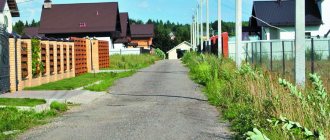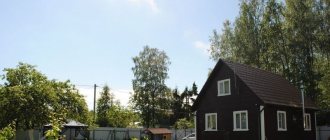Land transfer
The lands of a rural settlement have a fundamentally different type of permitted use from the lands of a gardening partnership - for individual housing construction.
Stages of transferring an ST site into a site for individual housing construction
- The owner of the plot collects a package of documents, prepares a petition to change the type of permitted use and submits it to the administration of the locality at the location of the land plot.
- Within 2 months, the administration must consider the application and make a decision on the transfer or refuse it. The decision is formalized in the form of an act of transfer of a land plot from one category to another or an act of refusal.
- Within 14 days from the date of the decision, the act is sent to the interested person.
- In case of a positive decision, changes are made to the cadastral documents of the site based on the act.
- If a transfer is refused, the interested person has the right to appeal the authorities’ decision in court.
Annexation may be refused for various reasons: for example, the territory of the partnership may be too far from the territory of the settlement, or due to the lack of necessary engineering and technical communications in the ST, or because the partnership has encumbrances that prevent reorganization.
How to transfer SNT to a populated area
Even before the pandemic, Russians traditionally went on summer holidays. Demographers believe that there are more than 60 million summer residents in the country. This is undisputed world leadership. With the announcement of self-isolation and quarantine, many rushed to the dacha. What if you don’t have your own garden house? We looked for a suitable option and rented it. There was even a shortage of country houses in the Moscow region, and in other regions.
However, life in a holiday village could be more comfortable. Oleg Valenchuk, who holds the post of Chairman of the Union of Gardeners and a member of the Committee on Natural Resources, Property and Land Relations of the State Duma, recalled that the mechanism for transforming a garden partnership into a populated area already exists. After all, according to him, traditionally about 10% of gardeners live in their dachas all year round.
The obvious problem with absentee voting
For now, the most pressing problem is voting. Due to restrictive measures, it is impossible to gather. There is a good initiative - the introduction of a bill that allows general meetings of members of the gardening partnership to be held online, remotely. However, the document has not yet entered into force.
Therefore, choosing a new chairman is not easy. And when the head’s powers expire, banks may begin to block SNT accounts. This entails the impossibility of repairing roads and electrical networks, removing garbage, etc.
So why not allow people to vote absentee? Oleg Valenchuk noted that citizens are ready for such innovations, but there are areas where this is technically impossible. The official gave an example: near a gardening partnership there is a tower of one cellular operator, and the Internet from other operators disappears. However, the deputy reassured that the issue is already being worked on.
Become a village
For populated areas (cities, towns, villages, etc.) there are advantages - in addition to the lack of the need to pay membership fees. Mainly social infrastructure. This includes the construction of medical facilities, the opening of kindergartens and schools, shops and entertainment venues. The status also allows you to count on the laying of utility networks, roads, etc. This is important if people live here for most of the year.
According to Oleg Valenchuk, a change of status is possible. But even here, everyone living in SNT must vote. After this, he says, the minutes of this decision (adopted at the general meeting) are submitted to the municipality. Next, we will have to wait to see what local governments decide, which, according to the official, are even interested in a larger number of taxpayers. The deputy emphasized that taxes will increase:
Oleg ValenchukDeputy of the State Duma of the Russian Federation. Chairman of the Union of Gardeners of Russia.
“Such changes entail changes in the master plan of a rural or urban settlement, urban district or district, as well as the territorial planning scheme of the municipal district within the boundaries of which the annexed territory is located. The category of land will change from “agricultural land” to “land of settlements”, and the type of permitted use of land will change from “for gardening” to land for personal farming or individual housing construction. What does it mean? That taxes will rise."
Joining a locality
Another mechanism is at work - the inclusion of SNT within the borders of nearby settlements. To do this, you need to approve or change the current general plan of the district or urban settlement, the planning scheme of the municipality - where this partnership is located. This is a labor-intensive process. After all, the category of land must be changed from agricultural to “land of settlements,” which may take a couple of years.
Nikita Chaplin, first deputy chairman of the Moscow Regional Duma, clarified that with a change in status, the cadastral value of the property will increase by 15-20% (taxes will increase), and the gate at the entrance to the partnership will be demolished.
Another minus
Oleg Valenchuk noted that if a citizen’s house becomes part of a populated area, it will, in fact, become a second home. And the dacha will be taken into account when putting a person on the waiting list to expand their living space.
Registration in a garden house
You can register with a gardening association. If in the Moscow region, then documents are submitted to the MFC, and in other regions, as a rule, through the migration service or passport office. But the house must be residential, permanent. This includes insulation and communications (electricity, water supply, etc.).
Oleg Valenchuk advised gardeners to consider all the pros and cons of transferring to a populated area.
Transfer of the Snt Plot to the Land of Populated Areas
The procedure, conditions and rights under which SNT members can use the specified property are determined at the general meeting of the partnership and are enshrined in the minutes. The property is acquired at the expense of the SNT participants, which means they have equal rights to it.
Having a dacha is a good tradition that dates back to the USSR. Many people have plots with or without buildings, inherited from their parents. When changing the conditions of the intended purpose, you need to know what legal status the land you own has. Most often, plots in private hands are of the type SNT or individual housing construction. Let's figure out what it is.
Is it possible to convert a dacha, garden plot or agricultural plot into land for individual housing construction?
- cadastral passport of the plot or an official extract of information about the land plot from the state real estate cadastre;
- a copy of a passport for an individual or an extract from the Unified State Legal Entity or Unified State Register of Individual Entrepreneurs - for a legal entity;
- an extract from the Unified State Register confirming the rights to this plot of land;
- consent of the land owner to change the current category of the land plot.
- the cadastral value of a land plot cannot exceed the average cadastral value for the region;
- To transfer agricultural land, a positive conclusion from the Ministry of Agriculture of the Russian Federation will be required, and an environmental impact assessment will also be required;
- The transferred plot of land must have the geographical possibility of adding it to the lands of the populated area.
Why should a locality join SNT?
Why should a locality take on the burden of gardening? It's all about tax revenues, which are sorely lacking in any budget. When gardening joins a populated area, its land category will immediately change.
- Previously: agricultural land with permitted use for gardening and horticulture
- It became: lands of settlements with permission for individual residential construction.
In practical terms, this means an increase in cadastral value by approximately 30%. From 2021, land tax is calculated based on cadastral value in all regions of our country. The marginal tax rate will also immediately increase, and five times: from 0.3% of the cadastral value to 1.5%, or five times more. Therefore, the locality will be glad to unite with a nice SNT, in which the roads meet the standards, the street lights are lit, the fire-fighting pond is functioning, and there are no abandoned areas overgrown with weeds. But if gardening is barely breathing its last, and things are going haphazardly, no one will take it on the balance sheet, the costs will be such that no taxes will cover them.
Glorf FORUMHOUSE Member
The administration very often does not have funds. In my neighboring village, the administration itself lives almost in full force - they cannot fix their own water supply, plans have been postponed for almost 10 years.
Is it possible to transfer a plot of land from SNT to individual housing construction and how to do it correctly? Step-by-step instruction
SNTs are always located on agricultural land. On plots intended for various gardening works, it is possible to build houses necessary for living in the summer. To obtain registration, year-round residence, use of material capital, and obtain a loan from a bank, it is necessary to transfer SNT into individual housing construction. There are no alternative options.
The result of the review will be either a reasoned refusal or the issuance of documents on the transfer of SNT to individual housing construction. It takes at least 2 months to consider the application. After the decision is made, it is transmitted to the applicant no later than 14 days. If the outcome of the case is positive, a corresponding act is issued. In case of refusal, a written reason.
Errors when transferring SNT to individual housing construction
When transferring a land plot that is part of the SNT to the status of land for individual housing construction, it is possible to receive a refusal in a number of cases:
- a person who does not have the authority to do so applied for the transfer of lands or land plots as part of such lands from one category to another;
- The application was accompanied by documents drawn up in violation of the law.
In case of refusal to consider the application, it must be returned to the interested person within 30 days from the date of receipt. The reason for refusal when considering an application must be explained in writing to the interested person.
Example 1. The Chesnokov spouses have owned a land plot that is part of SNT for 30 years. The land plot is registered in the name of the spouse, but the spouse applied to transfer the land plot from the SNT to the category of land plot subject to individual housing construction. This petition cannot be considered, because the spouse does not have the right to carry out this procedure.
Within 30 days, the Chesnokov family received a letter from the district administration refusing to consider the application for the transfer of a land plot from one category of land to another category of land with justification for the refusal (the application was submitted by a person who does not have the authority to do so).
[custom_ads_shortcode3]
Transfer of the Snt Plot to the Land of Populated Areas
Therefore, if your plot does not have borders with any settlement, then transferring this type of land is almost impossible. Let's look at the procedure for changing the type of land to individual housing construction: The owner who decides to change the type of land submits a petition to the authorized executive body or local government. In your petition you list:
For example, we are talking about high costs, as well as the need to coordinate the project and visit all regulatory organizations. All buildings on the land plot must strictly comply with current requirements, and the plot itself must meet the dimensional conditions.






